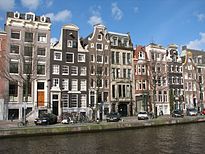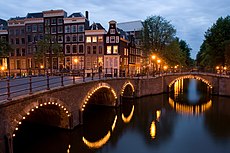Amsterdam
![]()
The title of this article is ambiguous. For other meanings, see Amsterdam (disambiguation).
Amsterdam (Dutch![]() ) is the capital and most populous city of the Kingdom of the Netherlands and ranks 19th among the largest cities in the European Union. The municipality of Amsterdam has 872,922 inhabitants (as of 1 January 2021) and as the agglomeration Groot-Amsterdam 1,394,998 inhabitants (as of 31 March 2021). While the country's seat of government and the royal residence are located in The Hague, 60 kilometres away, Amsterdam has been the capital of the Netherlands since 1983 in accordance with the Dutch constitution.
) is the capital and most populous city of the Kingdom of the Netherlands and ranks 19th among the largest cities in the European Union. The municipality of Amsterdam has 872,922 inhabitants (as of 1 January 2021) and as the agglomeration Groot-Amsterdam 1,394,998 inhabitants (as of 31 March 2021). While the country's seat of government and the royal residence are located in The Hague, 60 kilometres away, Amsterdam has been the capital of the Netherlands since 1983 in accordance with the Dutch constitution.
Amsterdam is located in the Dutch province of North Holland, on the canalized river Amstel and the former estuary IJ. The city's port is connected to the North Sea by the North Sea Canal. Amsterdam is world famous for its canals.
City breakdown
→ Main article: Municipalities of Amsterdam
Amsterdam has been divided into seven + one (= the commercial and industrial area Westpoort) boroughs since the reorganization on 1 May 2010. Before that, there were 14 boroughs, of which three remained unchanged and the others merged to form four new boroughs. Each borough has its own district administration and an elected district committee. The boroughs are in turn divided into the districts of Amsterdam (wijken in Dutch) as follows.
Amsterdam-Centrum
- Haarlemmerbuurt, Burgwallen-Nieuwe Zijde, Burgwallen-Oude Zijde, Nieuwmarkt/Lastage, Oostelijke Eilanden/Kadijken, Weesperbuurt/Plantage, De Weteringschans, Grachtengordel-Zuid, Grachtengordel-West and Jordaan.
Amsterdam-Noord
- Oostzanerwerf, Noordelijke IJ-oevers West, Tuindorp Oostzaan, Kadoelen, Banne Buiksloot, Volewijk, IJplein/Vogelbuurt, Elzenhagen, Noordelijke IJ-oevers Oost, Tuindorp Buiksloot, Buikslotermeer, Nieuwendammerdijk/Buiksloterdijk, Tuindorp Nieuwendam, Waterlandpleinbuurt and Waterland.
Amsterdam-Oost
- Oostelijk Havengebied, Zeeburgereiland/Nieuwe Diep, IJburg West, IJburg Oost, IJburg Zuid, Middenmeer, Betondorp, Frankendael, Omval/Overamstel, Weesperzijde, Transvaalbuurt, Oosterparkbuurt, Dapperbuurt, Indische Buurt West and Indische Buurt Oost.
Amsterdam-Zuidoost
- Bijlmer Centrum, Bijlmer Oost, Driemond, Nellestein, Gein, Holendrecht/Reigerbos and Amstel III/Bullewijk.
Amsterdam-Zuid
- Museumkwartier, Oude Pijp, Nieuwe Pijp, Zuid Pijp, IJselbuurt, Rijnbuurt, Scheldebuurt, Buitenveldert Oost, Buitenveldert West, Zuidas, Prinses Irenebuurt e.o., Stadionbuurt, Hoofddorppleinbuurt, Schinkelbuurt, Willemspark and Apollobuurt.
Amsterdam Nieuw-West
- Bedrijventerrein Sloterdijk, Slotermeer-Noordoost, Slotermeer-Zuidwest, Overtoomse Veld, Westlandgracht, Sloter-/Riekerpolder, Slotervaart Noord, Slotervaart Zuid, Osdorp-Oost, Osdorp-Midden, De Punt, Middelveldsche Akerpolder, Lutkemeer/Ookmeer, Eendracht and Geuzenveld.
Westpoort
- No subdivision into districts, but only into the following quarters (Dutch buurten): Afrikahaven, Amerikahaven, Westhaven Noord, Westhaven Zuid, Petroleumhaven, Vervoerscentrum, Coenhaven/Mercuriushaven and Alfa-driehoek.
Amsterdam-West
- Sloterdijk, Spaarndammer- en Zeeheldenbuurt, Houthavens, Centrale Markt, Staatsliedenbuurt, Frederik Hendrikbuurt, Kinkerbuurt, Da Costabuurt, Van Lennepbuurt, Helmersbuurt, Vondelbuurt, Overtoomse Sluis, Westindische Buurt, Chassébuurt, Hoofdweg e.o., Geuzenbuurt, Van Galenbuurt, Erasmuspark, De Kolenkit and Landlust.
Amsterdam gauge
→ Main article: Amsterdam gauge
The Amsterdam gauge was established as the zero point for height measurements in 1683/1684. The water level of the mean high water (MHW) was chosen. This water level was about 17 cm above mean high water. Today, the water level of the Amsterdam canals is about 40 cm below the sea level of the North Sea.
Climate
Dutch weather usually varies from a light frost in winter with some snow to sunny days of 20 to 30 °C in summer. Spring and autumn are mild, but can also be very wet and rainy (over 100 mm of precipitation per month).
Amsterdam's summers are very mild by Central European standards, with a long-term average of only 3.7 hot days and 21.9 summer days per year from 1991-2020. In winter, there was an average of 42.8 frost days and 5.8 ice days.
| Amsterdam | ||||||||||||||||||||||||||||||||||||||||||||||||
| Climate diagram | ||||||||||||||||||||||||||||||||||||||||||||||||
| ||||||||||||||||||||||||||||||||||||||||||||||||
| Climate data Amsterdam
Source: KNMI, data: 1991-2020 | |||||||||||||||||||||||||||||||||||||||||||||||||||||||||||||||||||||||||||||||||||||||||||||||||||||||||||||||||||||||||||||||||||||||||||||||||||||||||||||||||||||||||||||||||||||||||||||||||||||||||||||||||||||||||||||||||||||||||||||||||||||||||||||||||||||||||||
| Amsterdam | ||||||||||||||||||||||||||||||||||||||||||||||||
| Climate diagram | ||||||||||||||||||||||||||||||||||||||||||||||||
| ||||||||||||||||||||||||||||||||||||||||||||||||
| Climate data Amsterdam
Source: KNMI, precipitation: reference period 1971-2000, otherwise: 1961-1990 | |||||||||||||||||||||||||||||||||||||||||||||||||||||||||||||||||||||||||||||||||||||||||||||||||||||||||||||||||||||||||||||||||||||||||||||||||||||||||||||||||||||||||||||||||
Over the last 30 years, temperatures in Amsterdam have increased on a long-term average; while the average daily maximum temperature in August for the period 1961 to 1990 was around 21 °C, it is around 22 °C for the years 1991 to 2020. Winters have also become warmer; while the average daily maximum temperature in January was 4.6 °C for the years 1961 to 1990, it was 6.2 °C for the period 1991 to 2020.
Total annual precipitation has also increased; while the average precipitation for 1971-2000 was about 798 mm, it was about 850 mm for the 1991-2020 reference period.
Time zone
Amsterdam, as well as the entire European Netherlands, lies in the Central European Time Zone. Because the city is far to the west in this time zone, the sun is not exactly south until 12:40 pm (1:40 pm during daylight saving time). This, combined with the city's northern location, results in a late sunset in the summer; in the height of summer, it can still be light until 11pm.
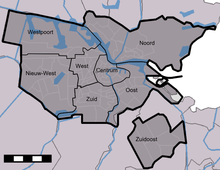
Municipalities of Amsterdam, since 1 May 2010
Architecture
Architectural features
In Amsterdam, over 8000 buildings are listed and six city and village views are protected.
Since in Amsterdam's history the canals were one of the main transport routes for goods and people, it was customary to assess the taxes for a building according to its width along the canal. As a result, Amsterdam mainly built houses with very narrow frontages along the canals, but which were relatively long and high in order to provide sufficient living space or storage space for goods. However, this type of construction did not lend itself to the construction of wide staircases; rather, the staircases were usually too narrow for bulky goods or furniture. Objects that were difficult to transport via the stairwell were instead carried into the house via the windows. To facilitate this process, the gables of many historic buildings have projecting beams to which pulleys can be attached. Furthermore, many façades slope slightly forward, this is architecturally intentional and is called op vlucht gebaut. The forward slope is 0.2 to 2.5 cm per metre in height. The gables could not be built in width because of the narrowness, but they were built in rich design in height. Gable variations from four centuries characterize the old town. Stepped gables, beak gables, bell gables and groin gables are particularly common.
Secondly, houses in Amsterdam used to be built on wooden piles, and these have slowly rotted away over the centuries. Therefore, the historic parts of Amsterdam make a slightly "crooked" or "distorted" impression. Amsterdam stands on about five million wooden piles, which are necessary because of the damp, sandy ground. Today, concrete piles are used because of longer durability, easier construction methods, and greater depth. The Central Station stands on about 8600 piles, the Royal Palace on 13,659 piles. A large proportion of these wooden piles were brought from the Black Forest and the Franconian Forest by rafts. All the piles for the main railway station, for example, came from the Franconian Forest. Also the timber for houses and ships as well as the firewood was transported by rafts from these forests.
See also: Canals in Amsterdam
Sacred buildings
- Amstelkerk (1668-1670, remodelled in 1840)
- De Duif (1858)
- Sint-Ignatiuskerk (De Zaaier), built in 1929 in the style of traditionalism, in use of the Roman Catholic Church until 1971, rededicated as Islamic Mosque in 1981
- De Krijtberg (1881) Roman Catholic Jesuit Church of St. Francis Xaverius
- Ronde Lutherse Kerk (1668-1671) secularised 1935
- Mozes en Aäronkerk (1837-1841)
- Nieuwe Kerk (1408)
- Sint-Nicolaasbasiliek (1884-1887)
- Noorderkerk (1620-1623)
- Ons' Lieve Heer op Solder - Museum Amstelkring (hidden church) (1661)
- Oosterkerk (1669-1671), no longer in sacred use since 1985
- Oude Kerk (first stone church built on this site in 1325, completed in 1560 in the form we know today) The Oude Kerk is probably the only church in the world whose churchyard is almost entirely surrounded by brothels.
- Paradiso (1879-1880) originally church of the Free Community (ndl. Vrije Gemeente), 1968 as Cosmic Relaxation Center Paradiso rededicated to youth center, today concert hall (rock, folk, soul, country, reggae, blues), club and cultural center
- Portuguese Synagogue of Amsterdam (inaugurated 1675)
- Uilenburg Synagogue
- Gerard Dou Synagogue
- Posthoornkerk (1860-1889), no longer in sacred use since 1963
- Singelkerk (1639-1640)
- Westerkerk (1620-1631)
- Zuiderkerk (1603-1611), no longer in sacred use since 1970
Amsterdam School Building
Amsterdam is home to many buildings in the style of the Amsterdam School, a style of expressionist architecture, among others:
- Bronckhorststraat 11-37, residential building
- Brug 283 (1913), bridge, Waalseilandsgracht / Buiten Bantammerstraat
- Residential block Eigen Haard (1914-1918), residential building, Spaarndammerplantsoen
- Gebouw Batavia (1918-1920), office building, Prins Hendrikkade 84-85
- Harm Smeengeschool (1924-1925), former school building, Droogbak
- Huize Lydia (1924-1927), former residential home, Roelof Hartplein
- Lyceumbrug (1926-1928), bridge, Olympiaplein
- Het Nieuwe Huis (1927-1928), residential building, Roelof Hartplein
- Olympic Stadium (1928), main venue of the 1928 Summer Olympics, Stadionplein
- Olympiahäuschen (1928), gatehouse of the Olympic Stadium, Stadionplein 18
- Scheepvaarthuis (1913-1916), office building, Prins Hendrikkade
- Het Schip (1917-1921), block of houses, Spaarndammerplantsoen 140
Postwar Architecture
There are nine objects in Amsterdam that are included in the Top 100 Dutch Monuments 1940-1958, which has existed since 2007:
- Jeruzalem housing estate (1950-1954), terraced housing estate, Watergraafsmeer
- Westereindflat (1956-1957), apartment block, Harry Koningsbergerstraat
- Warnersblokken (1957), apartment blocks, Johannes Worpstraat
- Philip Kohnstammhuis (1954-1958), neoclassical administrative building, Wibautstraat/Rhijnspoorplein
- Opstandingskerk (1955-1956), Bos en Lommerplein
- Sint-Josephkerk (1950-1952), Erik de Roodestraat
- Eerste Christelijke LTS Patrimonium (1952-1956), school, Vrolikstraat/Wibautstraat
- Clubhouse of the rowing club De Hoop (1952), Weesperzijde 65a
- National Monument, Dam
Parks and gardens (selection)
→ Main article: List of parks in Amsterdam
- Amstelpark in Amsterdam-Zuid
- Beatrixpark, also in Amsterdam-Zuid
- Diemerpark, in Amsterdam-Oost, nature and city park
- Hortus Botanicus Amsterdam (Botanical Garden) in the Plantagebuurt
- Martin Luther King Park, also in Amsterdam-Zuid
- Sarphatipark, also in Amsterdam-Zuid
- Vondelpark, the second largest park in Amsterdam's city centre (Oud-Zuid district), named after the playwright Joost van den Vondel
- Westerpark in Amsterdam West
Other
- Begijnhof with small Beguine dwellings, with origins in the 14th century. The house at number 34, dating from 1530, was long considered Amsterdam's oldest wooden house.
- Beurs van Berlage, the old Amsterdam stock exchange after a design by architect Hendrik Petrus Berlage
- Blauwbrug, eclectic Amstel bridge built in 1883
- Munttoren (mint tower), historical customs office, on the Singel
- Paleis op de Dam, Royal Palace on the Dam
- Magere Brug, Amstel bridge from 1670 in the city centre
- Nieuwe Amstelbrug, bridge over the Amstel after a design by Hendrik Petrus Berlage
- De Waag, historic city scales on the Nieuwmarkt, today with restaurant
- Red light district De Wallen (Oudezijds Voorburgwal, Oudezijds Achterburgwal and Warmoesstraat)
- Schreierstoren, historical fortified tower
- Montelbaanstoren, historical watchtower
,_Munttoren_--_2015_--_7233.jpg)
Munttoren
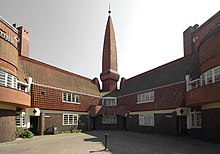
Het Schip

Westereindflat
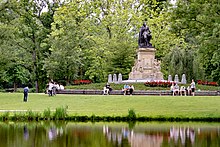
Vondelpark
| Row of houses with the relatively high buildings typical of Amsterdam | Crossing at the corner of Keizersgracht/Reguliersgracht |
Questions and Answers
Q: What is Amsterdam?
A: Amsterdam is the capital and largest city in the European country of the Netherlands.
Q: What is Amsterdam famous for?
A: Amsterdam is famous for its canals and dikes.
Q: Where is the national government and other official offices located in the Netherlands?
A: Unlike in capitals of most other countries, the national government, parliament, government ministries, supreme court, royal family and embassies are not in Amsterdam, but in The Hague.
Q: What educational institutions are present in Amsterdam?
A: The city hosts two universities (the University of Amsterdam and the Free University Amsterdam).
Q: What is the population of the metropolitan area of Amsterdam?
A: The population of the metropolitan area of Amsterdam is about 2.2 million people.
Q: What is the most multi-cultural city in the world?
A: The city of Amsterdam is the world's most multi-cultural city, with people living there from 175 different countries.
Q: What has happened on the 24th of March, 2022 with Amsterdam and Weesp?
A: The former city of Weesp has been part of Amsterdam since 24 March 2022, increasing the population of Amsterdam to about 905,000 people.
Search within the encyclopedia
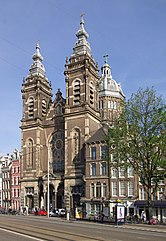
,_Westerkerk_--_2015_--_7179.jpg)
